#THIS IS ALMOST ENTIRELY REFERRING TO
Text
ok, I’m gonna say it. I have one HUGE fear for CR tonight: that they’re gonna bring Launda back (yay!), that they’ll do it under the Sun Tree (okay sure that’s thematic), aaaaand that symbolically reliving her first resurrection will somehow make Launda “At Peace” or “Okay With” her past and/or her present circumstances, or even make her ALIVE again. “Edgy/Creepy/Gothy character dies, is resurrected, and the experience gives them a new Inner Peace(tm) and makes them a more Mature (normal) (societally acceptable) (visibly happy) (lighter color-schemed) person” a trope I’ve seen in more or less every fandom I’ve been in (including CR), and I hate it enough that I’m actually getting a bit queasy worrying that I might be about to see it in action again. Please, Matt, Marisha, whoever is deciding this, if Launda does come back, don’t change her. Honestly, make her creepier. She’s the kind of person who would die, come back, comfort her friends, and then be a Little Shit about it for the rest of eternity. Please don’t force Launda into some kind of dress-shirt, “recovering scene kid”, respectyourselfloveyourself.gif arc just because she died. Please don’t. Goth people can be, and often are, happy. “Weird”, “Freakish”, “Spooky” ppl who collect puppets and dress like it’s halloween every day can be and are happy. That needs to be shown- so many “Edgy” characters die, resurrect, and immediately trade their black, red and snark for white, gold and a gentle smile. stop. let weird kids have a future that isn’t death or normalcy.
#critical role spoilers#critical role liveblog#ik this sounds ranty but yall#this trope happens SO MUCH#Shiro#Catra#Spn definitely TRIED but it cant rly un-edge itself#and it always feels so plastic#it also sends a really bad message!#and mimics really harmful stuff irl!#there's SO much pressure to stop dressing abnormally once you're an adult#and stereotypes of adults who wear alt fashion as EITHER doomed OR recovering#not just existing#honestly the term recovering scene/alt/emo/goth kid#is funny in a vacuum but not when its framed against Resepectability Culture irl#i SHOULD NOT HAVE TO SAY THIS BUT#THIS IS ALMOST ENTIRELY REFERRING TO#NON MALE#NON CIS#QUEER#BIPOC#<ESPECIALLY BIPOC!!!!!!!!#DISABLED AND NEURODIVERGENT#PLUS SIZE#AND LOWER INCOME PPL#pretty skinny white kids who can afford to shop at killstar arent gonna much crap as they age#but everyone else? whoooo boy.#tw rant#anyway. i really hope this doesnt happen#but either way um This Trope Sucks In General And Should Stop
5 notes
·
View notes
Photo


Shout-out to both Nico and Hazel, immediately after their character introductions, explicitly cussing/telling another character to shove it. It runs in the family.
#pjo#riordanverse#hoo#heroes of olympus#nico di angelo#hazel levesque#these two definitely swear the most out of the entire Argo 2 crew#our first impressions of them more or less are them cussing#i almost included another screenshot of Hazel cussing but i decided to just make this post this pair of quotes#cause they match#i kinda wanna make a pjo swearing compilation cause i feel like that'd be funny#insert that one paragraph of Percy actually explicitly non-censored cussing but he's referring to a donkey so it's okay
3K notes
·
View notes
Text
Characters Bios for The Boys in the Boat


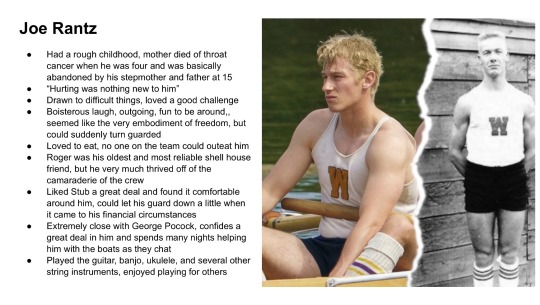






#PLEASE LET ME KNOW IF I GOT ANYTHING WRONG#I WILL GLADLY FIX IT#source was almost entirely the book by Daniel James Brown#bobby moch#the boys in the boat#boys in the boat#character bios#fanfiction references#fic resources#information#references#research#character guide#Don Hume#Johnny white#Joe Rantz#chuck day#roger morris#george shorty hunt#george hunt#Gordy Adam#James stub McMillan
138 notes
·
View notes
Text
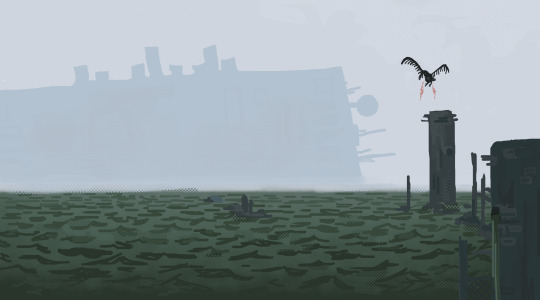
ehhhh ok im posting this one because i spent too much time drawing all those waves but im not super happy with it
#i didnt check any references so the shoreline tower thingies are probably super innacurate lol#rain world#art#fish makes art#fun fact i know this took almost exactly 50 minutes because it took the entire length of my discussion section class
130 notes
·
View notes
Note
I’d love to know about Yulma and how important it is to representation in shounen manga
This has been sitting in my askbox for a couple months (because I am incapable of punctuality), but anon sent this to me back when I was talking about Yulma over on my vnc blog. For those unaware, Yulma refers to Yu Kanda and Alma Karma from the manga D.Gray-man.
So the thing is, to be honest, I don't know if you can say Yulma is/was important for representation. They don't tend to get brought up as an example of representation (except by diehard d.gray-man fans like me, lol) in shonen, and their whole thing is complicated enough that I feel like the queerness of it all flies over a lot of people's heads.
However! They're very important to me personally, and I do think it's kind of remarkable their story came out in like 2010. Because even though their queerness gets overlooked a lot, it's like. really there no matter how you interpret it.
The short version of their very complicated story is that Kanda and Alma are a couple who were resurrected into new bodies. Alma was a woman when they were originally together in their past lives, but is physically male in the present. Kanda is still very much in love with them by the end of their story, which, depending on the reading, makes Kanda very bi and/or Alma very trans.
This sound like something you want details on? If so, let's talk about how D.Gray-man's fan favorite edgy badass toughguy character briefly became the star of his very own heart-wrenching tragic queer romance.
Here's a brief crash course in Yu Kanda and Dgm for the uninitiated:
D.Gray-man is a manga about a group of exorcists (in the loosest and most anime sense of the term) in the 1890s fighting a holy war against mechanical demons powered by the souls of the dead. There are two things you need to understand about this plot for me to explain Yulma:
The Black Order, the secret branch of the church that exorcists work for, has a long history of committing horrific human experiments to further the war effort.
Due to complications of world building, only a tiny number of people can become exorcists, and tracking down new ones is extremely difficult.
Yu Kanda is one of the exorcists, and though not the actual main character (that's the lad in my icon), he's a very important secondary character. Arguably he's the most important secobdary character, since he's the main guy's biggest foil and the first character to play deuteragonist in a major story arc. He's also a huge fan favorite. The character popularity polls that Jump used to do always had him and the mc going back and forth over who won #1 most popular.
Kanda was also a classic edgy toughguy character. His first two scenes are him almost murdering the main guy because he thinks he's an intruder, then complaining about people grieving for their friend too loudly. He never smiles. He argues with the righteous mc about wasting time/energy protecting civilians. He threatens (and delivers) violence on anyone that annoys him. He looks like this:
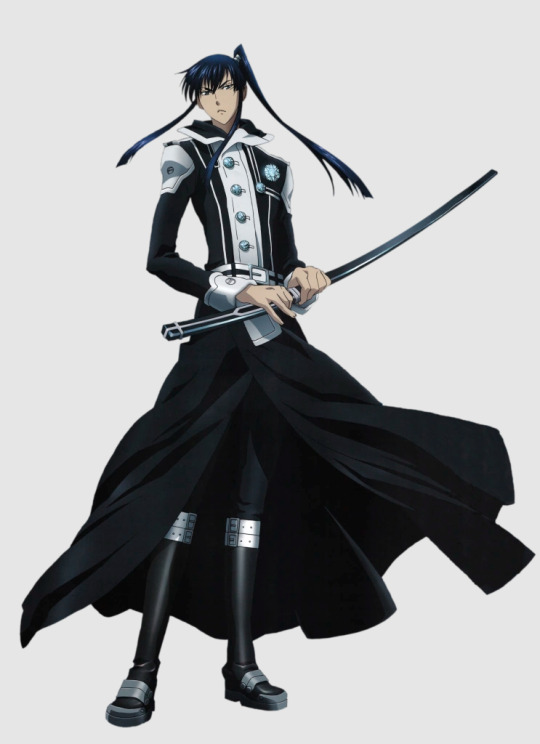
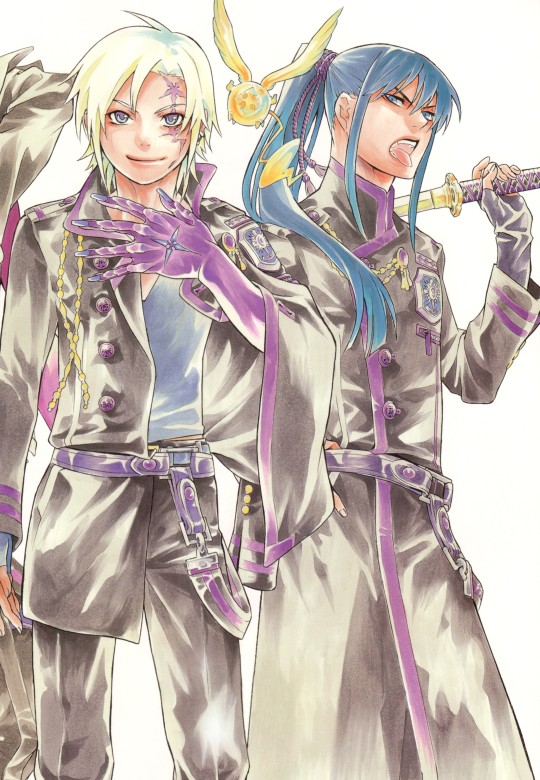
TLDR; Kanda was an adored-by-fans mean badass archetype in a 2000s shonen manga. Not generally the guy you peg for starring in a piece of queer romantic storytelling.
And for the entirety of the original anime adaptation's 103 episode run, for the first 188ish chapters of the manga, you do not learn a single thing about his early life. You learn he joined the Black Order very young, and you meet the mentor that took him in at that point, but although there are little hints, a couple cryptic mentions of him searching for a certain person, his early origins remain a complete black box.
Then came the Alma Karma arc.
This is the point where I start getting into spoilers.
To make a very long story short, the Alma Karma arc reveals that Kanda is one of the Black Order's human experiments. The Order ran a secret project 9ish years before the start of the series in which they essentially tried to re-use dying exorcists (since finding new ones is so hard). They took the bodies of dying or recently deceased exorcists and harvested their brains, implanting those brains into new magically grown child bodies.
Key to this project—the second exorcist project—is that these newly grown second exorcists were not supposed to remember anything from their previous lives. Kanda, however, recovered a few hazy memories from his past self. Most importantly, he can recall an unclear image of the woman that his past self was in love with. This memory gradually becomes Kanda's reason to live. He wants desperately to find and meet that person.
Now, aside from Kanda, there was one other successfully revived second exorcist. This was a boy named Alma Karma.
Over the course of their brief shared childhood, Kanda and Alma become extremely close. However, due to a series of horrible events that I'll spare you the details of, Alma is eventually driven to murder-suicide. He wants himself and Kanda to die together to spite the Order, and Kanda almost lets him do it.
The one thing that keeps Kanda from letting Alma kill him, the thing that drives him instead to kill Alma, his most beloved and only friend, is that he can't bear to die without finding that woman again.
Have you figured out the twist yet?
9 years later, in the present, Kanda discovers that he didn't actually quite kill Alma. The Order kept Alma secretly half-alive in order to do more dubious experiments. And, more importantly, when they meet again, Kanda discovers the truth. The woman that he's been searching for his whole life, the woman he's in love with, the woman he tried to kill Alma in order to find, was also killed and made into a second exorcist. And her brain was placed into the body of Alma Karma.
After quite a lot more violence and tragedy, Kanda and Alma end their story arc by running away together on their deathbeds. Alma dies, for real this time, in Kanda's arms, and his last words are to tell Kanda he loves him. These words are presented as something Kanda hears from both the boy and woman versions of Alma's soul.
So! At the end of a very long and complicated story, one thing holds true: Kanda and Alma are in love. As passed down from their past selves, they are specifically in romantic love. They were a couple. And to speak as a fan, the sheer absolute devotion to how Kanda's love for Alma is presented is seriously intense and moving.
Now, given the absolute hell that is Alma's life, gender identity is frankly the last thing they have time to worry about, so it's hard to say how the whole "literally a woman's brain in a male body" thing might have settled for them if given time to think about it. But that is inherently a pretty trans narrative. And given the whole Alma gender situation, there's simply no reading of their whole situation where neither of them is queer.
If you take present day Alma as a guy, which is more or less how he's presented in canon (though again, who knows how he would've felt about that male body in different circumstances), then congratulations! You've got mlm in your shonen manga. They were straight in a different life, but now one of them's a dude, and they are still deeply in love with each other. They've even got not one but two "let's forget it all and run away together" scenes, just as every mlm couple seems to have.
On the other hand, if you go with the angle that Alma's still a woman based on her mind/soul, even in her new body, then Kanda may not be canonically queer, but Alma is inarguably trans. Again, literally a woman's brain in a male body. It may not be how most people end up trans, but that doesn't change the facts of her situation.
You see what I mean about how they're undeniably queer, but also kind of easy to miss? There's so much other insane shit going on in their story that Alma's whole gender situation can get passed over. Plus, you can look online to this day and find people arguing that Kanda's not "technically" explicitly in love with the present day male version of Alma, since he doesn't 100% unambiguously say as much. I love reading comprehension.
Also! As a possible extra reason for why people don't talk about them much, the official English translation of the manga translated Alma's final "I love you" very differently. There's always a lot of nuance and argument when it comes to translating "大好き" into English, but given the full context of their relationship and the scene it's in, Viz's handling really sets off the censorship bells in my head.
Here's the different versions (Japanese then fan then official), if you want to compare:
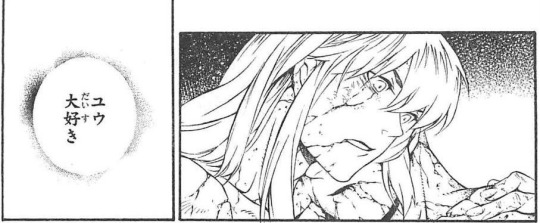
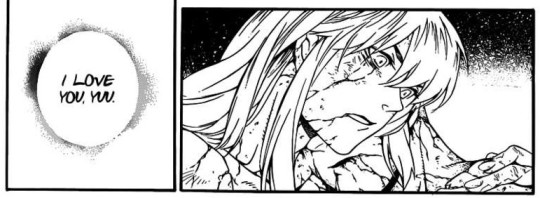

Nothing more classically queer than censorship by way of questionable translation 🙃.
At the end of the day, Kanda and Alma are in kind of a strange middle ground. They're each in love with the other one, but the whole second exorcist brain transfer situation makes it complicated enough that people argue their feelings aren't explicitly romantic (and thus not gay) in the present. Alma is literally a woman's brain implanted in a male body, but we don't have time to dwell on the gender complications of all that because of the hell that is the rest of their life. They're canon but not canon—queer people whose stories don't have space for them to be queer.
However, given that all this messy, tragic ambiguity was published in a fairly popular shonen manga back in 2010, it still feels kind of remarkable to me. Alma is somewhat an antagonist (it's complicated), and he dies at the end of his arc, but once again, Kanda was/is the fan favorite! And when he re-enters the main story after Alma's death, he's more important than he's ever been, and his history with Alma continues to be a huge part of his character.
Katsura Hoshino took the much-beloved edgy toughguy character from her long-running shonen series and, after keeping his origins secret for such a long time, confirmed that his whole life has revolved around love this entire time. Almost every facet of his character can be traced back to his love for his lost best friend or his yearning for his past life's missing partner. And then she reveals that the best friend and the partner are one and the same.
You can go back and forth about the degree to which they work as representation, but in any case, I think their story is something people ought to know about. It's romantic and it's heart-wrenching and it's fucking wild, especially given the context in which it was published (a Shonen Jump spinoff in 2010). I never see anyone besides the few remaining hardcore dgm fans talk about them, and I think that's a shame.
So anyway, that's tale of one of the most insanity-inducing romances I've ever seen put to paper. I love queer people.
Here's some choice pages if you want to cry with me (the last two are a sequence):
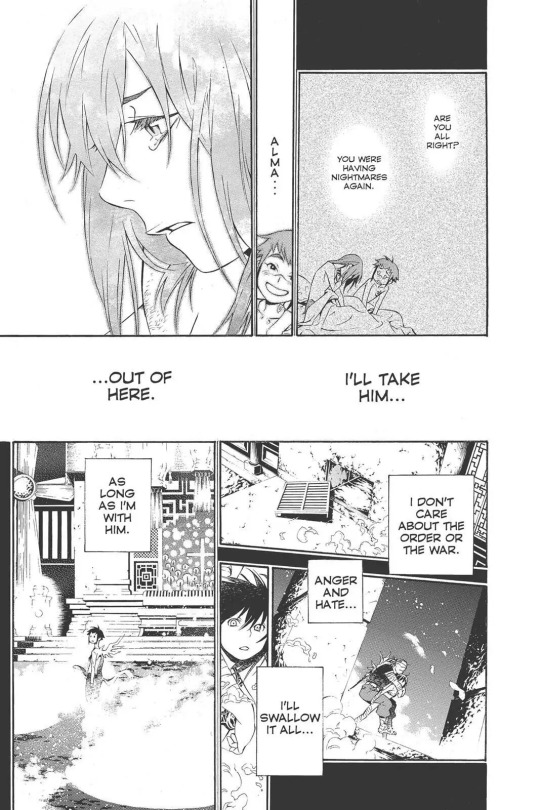
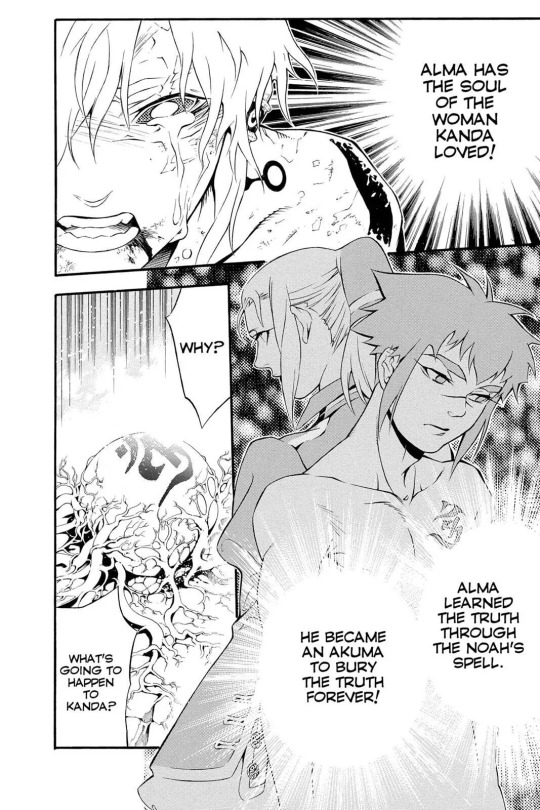
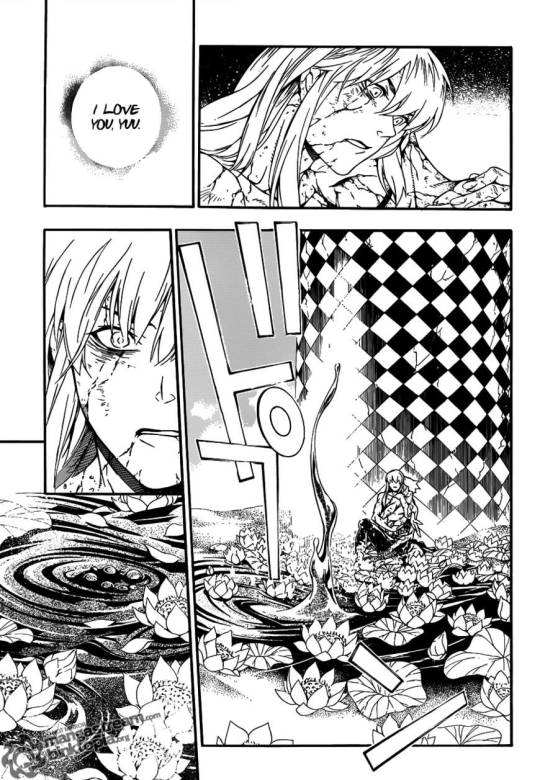
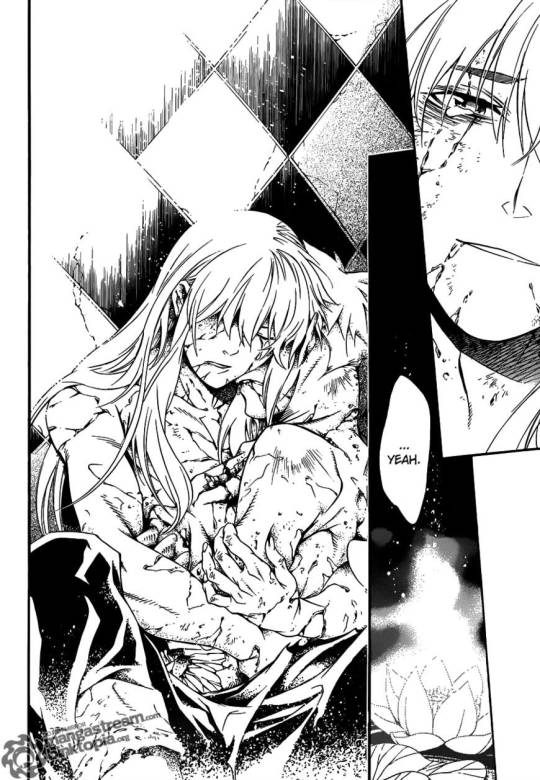
#followers!! I know my demographic#I know that most of y'all are Tragic Queer Romance Enjoyers#and if that describes you. you should read this post#come learn about a truly wild piece of manga history#I bring you the gift of discovering Yulma without having to read almost 200 chapters of shonen manga for context#don't pass this up <3#dgm#d.gray-man#yu kanda#yulma#alma karma#invasion of the frogs#also I really hope that at least one of the besties reads this and has a Realization about who/what my queue tag is a reference to#maybe I flatter myself to think that anyone remembers what my queue tag is. but I just think it would be funny <3#also also. I really did not intend for this post to turn into an entire essay when I started writing it#so uh. whoops#ID in alt text#anon#ask
176 notes
·
View notes
Text
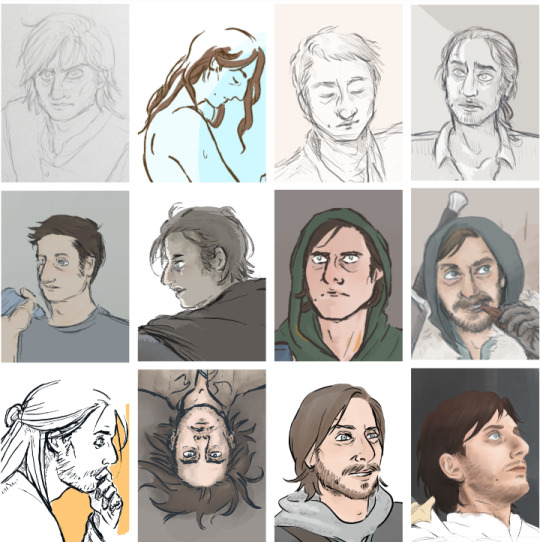

My Neekeys over the last two-odd years. I was curious to see the changes 🤔
#forgive the low quality dfghfds it was just an experiment#now to do the DRAW ANYONE ELSE challenge#siggy draws#he is my blorbo. my muse. i guess#don't get me wrong. i am CRINGING and SWEATING at just the thought of uploading this.#have i been drawing almost every day my entire life? yes. does my style still change all the time? yes!#and i'm mostly self-taught so i struuuuggle a lot. i'll finally admit that reference pictures help immensely. no shit lol.#i learned a lot in the last 2 years!!! there are some really ugly ones i didn't show but i kept the cringe old ones sdfghfds help.#i mean they're still here on tumblr so i can't exactly hide them#you can kind of see when i actually started to use reference pictures. and when i got more used to using a tablet#idk digital art is so hard. it's a whole other world. but i'm in it now and haven't drawn traditionally in forever#i can also literally see how i used to CRUSH my nibs while drawing. all those really thin lines?? i pressed too hard lol#i've actually kept all my nibs since i started drawing digitally and....... it's too many fghfds#that one slightly more realistic nicky in the bottom right of the first collage lmaooo. i should finish him... maybe... it's haaard.#the top right on the first collage and bottom right on the second one are good comparisons ;_; they're both pirate!nico gifts for lily!!#i'm feeling sentimental now omg
163 notes
·
View notes
Text
It’s important that the first revelation of Nissa Nissa is accompanied by some level of skepticism from Salladhor Saan and aversion on Davos’ part. It doesn’t sound right that Azor Ahai chose to sacrifice his wife for a magic sword. It shouldn’t sound right.
“A hundred days and a hundred nights he labored on the third blade, and as it glowed white-hot in the sacred fires, he summoned his wife. ‘Nissa Nissa,’ he said to her, for that was her name, ‘bare your breast, and know that I love you best of all that is in this world.’ She did this thing, why I cannot say, and Azor Ahai thrust the smoking sword through her living heart. It is said that her cry of anguish and ecstasy left a crack across the face of the moon, but her blood and her soul and her strength and her courage all went into the steel. Such is the tale of the forging of Lightbringer, the Red Sword of Heroes.
“Now do you see my meaning? Be glad that it is just a burnt sword that His Grace pulled from that fire. Too much light can hurt the eyes, my friend, and fire burns.” Salladhor Saan finished the last grape and smacked his lips. “When do you think the king will bid us sail, good ser?”
[…] A true sword of fire, now, that would be a wonder to behold. Yet at such a cost … When he thought of Nissa Nissa, it was his own Marya he pictured, a good-natured plump woman with sagging breasts and a kindly smile, the best woman in the world. He tried to picture himself driving a sword through her, and shuddered. I am not made of the stuff of heroes, he decided. If that was the price of a magic sword, it was more than he cared to pay.
Not only does it not make sense that Nissa Nissa would agree to her husband’s request, it’s also telling how Salladhor Saan expresses relief in knowing that King Stannis didn’t actually forge Lightbringer. Because forging Lightbringer means human sacrifice. And why should one be deprived of their life, even if it’s for a magic sword? Davos is very right to be creeped out by it.
The theme of sacrifice shows up quite a bit in ASOIAF and Davos I isn’t the first or last time. The very first chapter in the series, Bran I, tackles this idea with Jon and the direwolves.
“Lord Stark,” Jon said. It was strange to hear him call Father that, so formal. Bran looked at him with desperate hope. “There are five pups,” he told Father. “Three male, two female.”
“What of it, Jon?”
“You have five trueborn children,” Jon said. “Three sons, two daughters. The direwolf is the sigil of your House. Your children were meant to have these pups, my lord.”
Bran saw his father’s face change, saw the other men exchange glances. He loved Jon with all his heart at that moment. Even at seven, Bran understood what his brother had done. The count had come right only because Jon had omitted himself. He had included the girls, included even Rickon, the baby, but not the bastard who bore the surname Snow, the name that custom decreed be given to all those in the north unlucky enough to be born with no name of their own.
Their father understood as well. “You want no pup for yourself, Jon?” he asked softly.
“The direwolf graces the banners of House Stark,” Jon pointed out. “I am no Stark, Father.”
Jon, though he may desperately desire to have his own piece of magic, would not sacrifice his siblings for it. He wouldn’t dare to deprave the girls, Arya and Sansa, of their own magic even when it might be very easy to do so. This is a pretty stark contrast (pun intended) to Azor Ahai and his Nissa Nissa. Azor Ahai’s first line of thought was to sacrifice his wife whereas Jon’s was to sacrifice himself. Sure Azor Ahai got his magic sword, but Jon’s self-sacrifice is not in vain either because he later earns his own wolf, who turns out to be even more special than the rest in the pack.
Bran IV kind of alludes to the idea of self sacrifice through Old Nan’s retelling of the last hero:
So as cold and death filled the earth, the last hero determined to seek out the children, in the hopes that their ancient magics could win back what the armies of men had lost. He set out into the dead lands with a sword, a horse, a dog, and a dozen companions. For years he searched, until he despaired of ever finding the children of the forest in their secret cities. One by one his friends died, and his horse, and finally even his dog, and his sword froze so hard the blade snapped when he tried to use it. And the Others smelled the hot blood in him, and came silent on his trail, stalking him with packs of pale white spiders big as hounds—”
Though the one we know is called the “last hero”, notice that it’s not a title but a mere descriptor; there were many heroes before him who died and he was the last one standing. There is a human toll in this legend, but it’s implied to be self sacrifice. It’s also interesting that though there is mention of a blade, it is the children of the forest’s magic that is key. This does kind of bleed into what we know about the Night’s Watch and its relation to the long night. The Night’s Watch victory was a group effort, rather than the actions of any one man.
We have several legends surrounding the long night that work, but only one involves the cost of sacrificing someone else (that we know of). This might be where GRRM is headed with Stannis and his creation of Lightbringer. Sure Azor Ahai did get his magic sword, but it doesn’t negate the steep human cost. GRRM has lowkey confirmed that Stannis is sure to burn Shireen. And rather than this sacrifice not working, I think it’s more likely that it does work. Stannis does indeed create the flaming sword. But this will be directly weighed by other (self) sacrifices made for the same purpose. Stannis’ sacrifice of his daughter won’t work any better than other characters who choose to sacrifice themselves even when knowing that they are not going to go down as individual legends; I think Jon Snow will once again be the prime example of this, as he has already resigned himself to being a shadow in history despite initially wanting the opposite. Maester Aemon was right in saying that
[…] all deceive ourselves, when we want to believe. Melisandre most of all, I think. The sword is wrong, she has to know that … light without heat … an empty glamor … the sword is wrong, and the false light can only lead us deeper into darkness, Sam
The sword is wrong. Azor Ahai is NOT one to be emulated. Rather, he should be a cautionary tale. He is not any more special for his sacrifice than what the last hero or the men of the Night’s Watch did, even though we know his name but don’t know theirs. GRRM answered the question regarding sacrifice before he even posed it. To make someone else pay the price is flat out wrong. The only true and worthy sacrifice is really that of the self.
#asoiaf#valyrianscrolls#azor ahai#the last hero#stannis baratheon#jon snow#the night's watch#didn’t put in the post but if Jon’s ADWD dream turns out to be true and he does gain his own flaming sword i tend to think he’ll get it#by giving up himself or part of himself in the process#jon is perhaps the most self sacrificial character in this series#which is why theories that dany will be his nissa nissa miss the mark almost entirely#if jon is to be a hero he will do it by sacrificing himself not someone else#he already demonstrated this in agot when he refused a direwolf and again in adwd when he refused winterfell#stannis is meant to be his foil so we could see them being weighed against each other#not to mention that jon’s adwd dream is very much a last hero retelling with references to his companions falling#and him outlasting them though there’s a really interesting reference to him killing robb and ygritte#but I think it’s more to do with killing his own desires to remain at the wall - in addition to his feelings of guilt and abandonment
43 notes
·
View notes
Text
Here's a little comic based off of @teatitty idea of "[Geralt & Dandelion] both looking wet and pathetic after getting caught in a sudden downpour and bickering over whose fault it is"
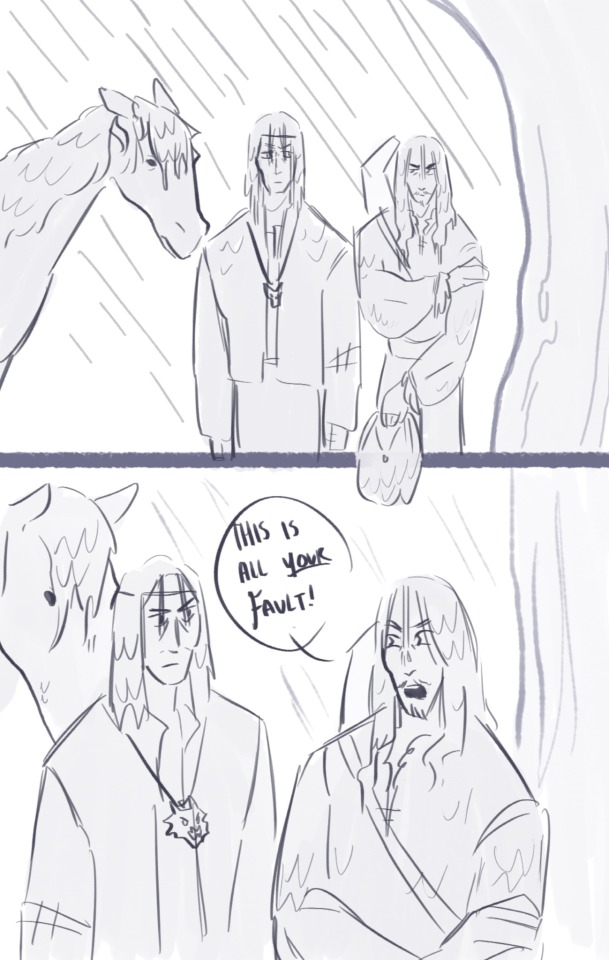
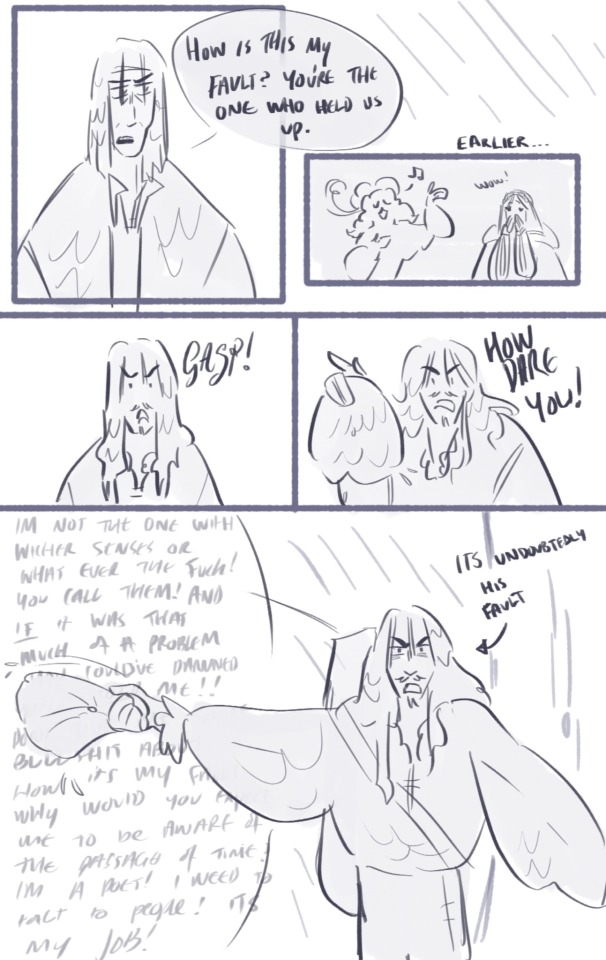

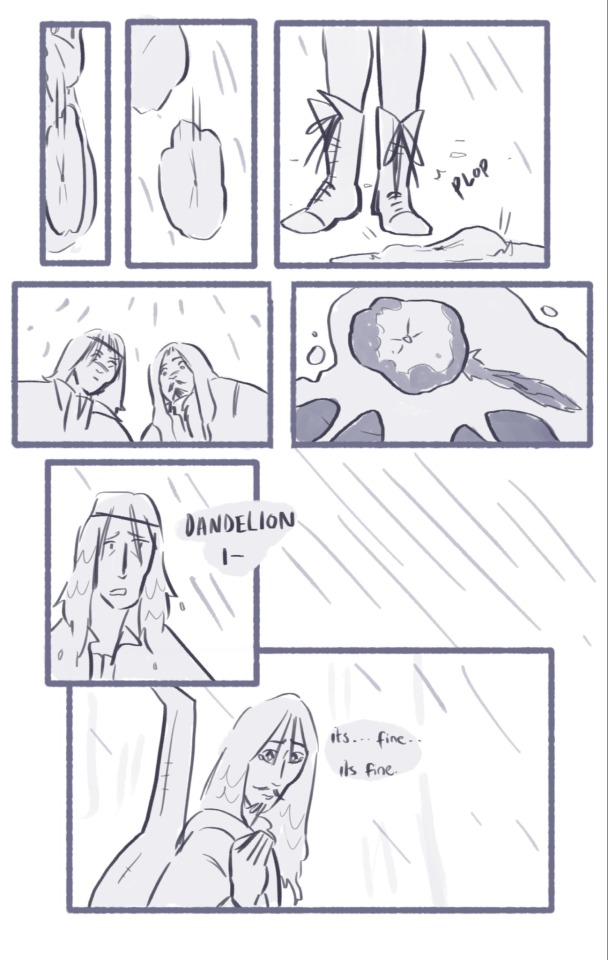
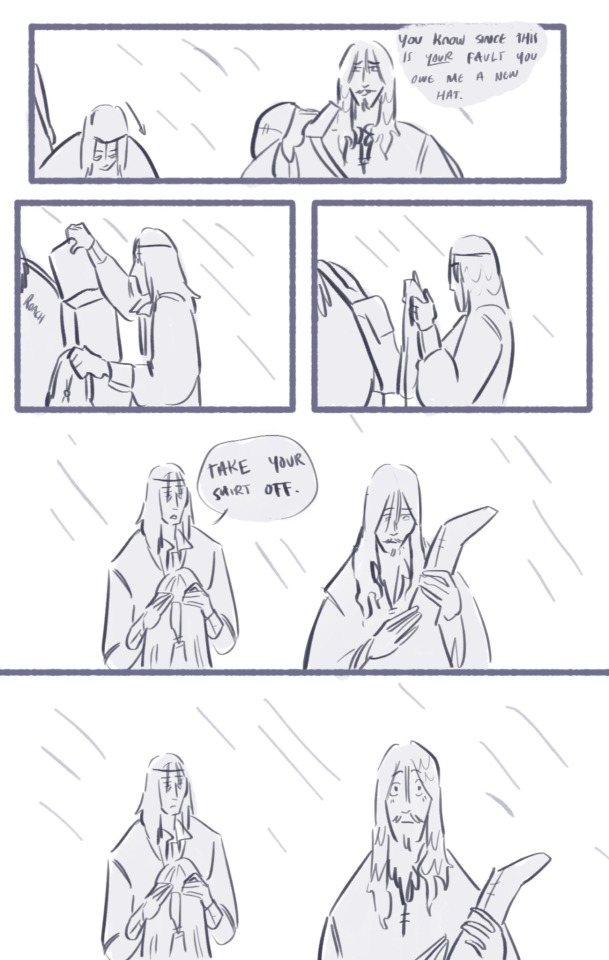
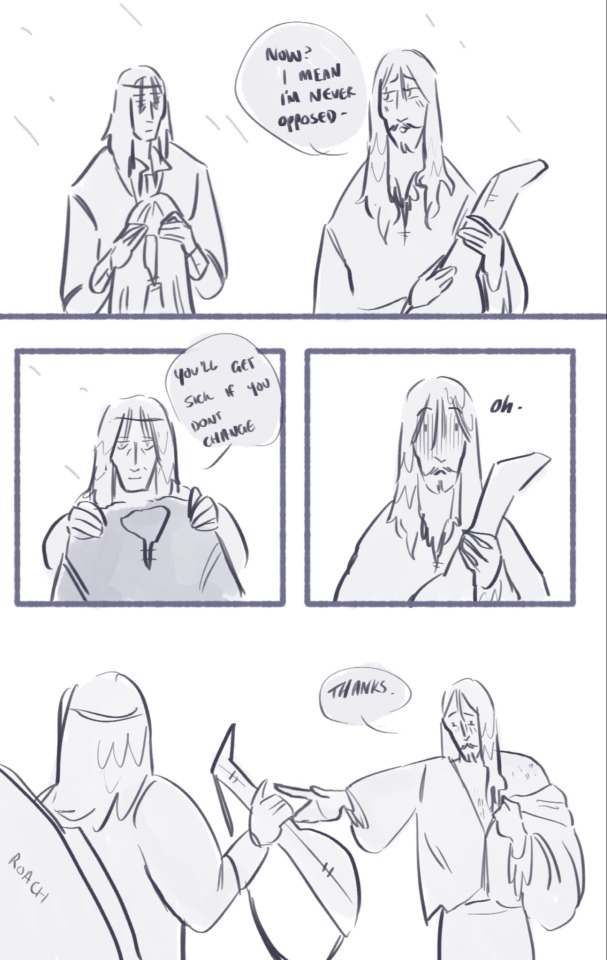

I like to imagine this is set within the first few years of them travelling together when they're still learning each others boundaries and what not.
#the witcher books#dandelion#geralt of rivia#gerlion#the Witcher#my art#this almost turned incredibly angsty and I really had to reel it back in#also! the ending is a reference to my first ever posted gerlion art 'a moment of respite' :D#the entire time I was making this I was thinking about when I got caught in a flash flood in my bard outfit#I had to sprint to the banquet hall- lyre clutched to my chest out of fear it would get water damaged#let me tell you- a doublet and leggings are sensory hell when soaked
51 notes
·
View notes
Text
i actually don't think it would've made sense for martyn to get the boogey task.
it was literally.. a boogey task. you know, the mechanic where greens and yellows were forced to kill against their wills? because it wasn't actually a zombie apocalypse, remember. not to mention it would've completely destroyed the enter gimmick of the typical red life tasks, which are meant to be fun creative new ways of hurting/killing. also, I think red tasks are set up the way they are in part to increase the survivability of red names, which was super important this session seeing as there was only one left.
also, we all saw how low gem got leading that army through several kills. she died eventually, and even if it was scar killing her accidentally, she was so low at that point it was guaranteed she was going to die for that task. if that was martyn, he wouldn't have even been able to go get a new red task and get some hearts back you know?
"martyn didn't get to do anything because of it!" that was also his choice though! he could've said hey, you guys are slaughtering people? awesome let me tag along. instead he made the decision to stay far away from that because he was very concerned about the way that was going. he purposefully excluded himself from that; there was no stipulation in the book saying "red names can't be involved or help you kill people". I'm not sure if martyn thought that was the case, but it certainly wasn't
idk, I think the fact that it was referred to as "the zombie apocalypse" all session made people forget they weren't actually zombies. they were boogeymen. that distinction matters a LOT
#i dont even want to address the “it was so forced” thing#as if that's not this seasons entire gimmick#theres an all powerful being forcing tasks upon them.. this isnt even the first clearly orchestrated task#no one had qualms with the wither + warden from session 6#but that was clearly very manufactured too#“everyone knew what it was!”#except they didn't though#not a single survivor ever spoke the exact wording of the book#almost all of them except joel werent even referring to it as boogeymen#but just “zombie apocalypse”#no one figured out the most recent infected had to participate in the kill for it to spread#idk! i think a cool mechanic from a past series was nodded at much like grians double life themed task#and people sort of took it the wrong way#secret life#trafficblr#ian yammers
64 notes
·
View notes
Text

flowers bloom in secret - a harumiyu playlist
alt versions under cut

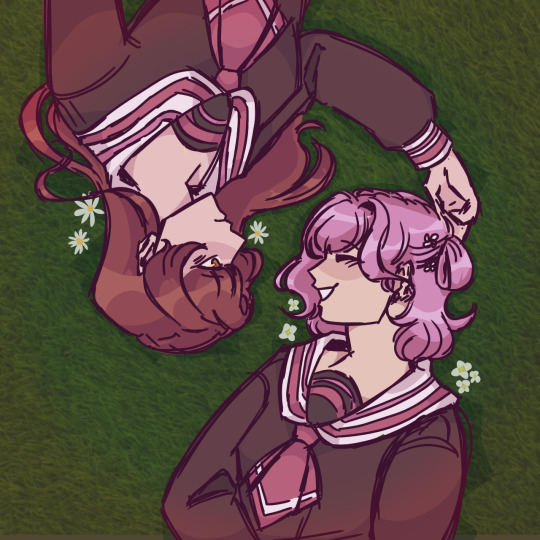
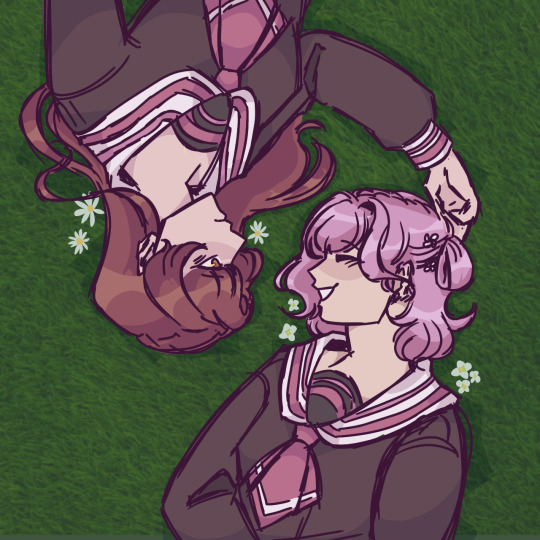
#itlog's arts#d4dj#d4dj groovy mix#lyrical lily#haruna kasuga#miyu sakurada#harumiyu#FINALLY i finished working on this playlist. its been almost an entire year. i still have the concept sketch christ#fun fact this was actually supposed to be a fic but i had no idea what to do with the plot so here's an outline:#first part is from haruna's pov; turning point (kiss the girl) is where kurumi and miiko pop in to help their dear chairwoman out#and then after is miyu's pov and then a joint pov for both haruna and miyu:)#i gave them a happy ending! not really the original course of action but oh well#i only started working in this again since i found the PERFECT reference image so everyone say thank you pinterest:)
52 notes
·
View notes
Text


Yeah. Like if you agree.
#if you need a hint of what i am referring to it is in the pants#the utter flagrancy#an entire crew looked at this man and said 'no you look fine don't worry about it' almost every week for 8 years#the good news is if you don't care about the subject matter of this post you can still appreciate hawk hovering in the first cap#bj hunnicutt#hawkeye pierce#m*a*s*h#s6e11#the m*a*s*h olympics#thirstcapping#mashposting#mashblogging#tdp
30 notes
·
View notes
Note
I heard that Edward IV and Elizabeth Widvile were known to be very beautiful. Were there any reports on their appearance at the time?
anon 😂
But yes, contemporaries and post contemporaries in the 16th century were pretty much unanimous in praising their appearance. I'll list some of the ones I could find:
Elizabeth:
'The most beautiful woman in England' ('la plus belle fille d'Engleterre') - Jean de Waurin
'Her very great beauty' ('sa tres grande beaute') - Jean de Waurin
"Her beauty of person and charm of manner" - Dominic Mancini
"None of such constant womanhood, wisdom and beauty" - Hearne's Fragment; its author was one of Edward IV's servants
"A daughter of prodigious beauty' - 1469 Continuator of Monstrelet's Chronicle
"Both faire, of a good favor, moderate of stature, well made and very wise" - Thomas More
Edward IV:
"The beauty of your personage it hath pleased Almighty God to send you" - James Strangways, Speaker of the Commons in Parliament
"The king is a handsome upstanding man" - Gabriel Tretzel, travels of Leo of Rozmital
"A handsome prince and had style" - Oliver De La Marche
"In the flower of his age, tall of stature, elegant of person" - Croyland Chronicle
"One of the handsomest knights of his kingdom" - 1469 Continuator of Monstrelet's Chronicle
"A handsome and worthy prince" - Pietro Alipranto
‘...Tall and strapping as the king’ - John Paston, Paston Letters
"He was young and more handsome than any man then alive" - Philippe de Commynes
"A man so vigorous and handsome that he might have been made for the pleasures of the flesh" - Philippe de Commynes
"The handsomest prince my eyes ever beheld" and "I don't remember ever having seen a man more handsome than he was" - Philippe de Commynes
"A very handsome prince" - Louis XI, from the Memoirs of Commynes
"He being a person of most elegant appearance, and remarkable beyond all others for the attractions of his person" - the Croyland Chronicle, referencing Edward a few months before he died
"He seized any opportunity that the occasion offered of revealing his fine stature more protractedly and more evidently to onlookers" - Dominic Mancini, writing shortly after his death
"He was a goodly personage and very princely to behold...of visage lovely, of body mighty, strong and cleanly made; howbeit in his latter days, with an over liberal diet, somewhat corpulent, but nevertheless noy uncomely" - Thomas More
Etc.
I'm tagging @edwardslovelyelizabeth because I think you got a similar ask?
I hope this answers your question, anon! I don't generally pay a lot of attention to the physical appearance of historical figures (I find it pretty irrelevant), but in this case, it ultimately does play a role in both Edward IV and Elizabeth's historiographies for better and for worse, and seems to have actually been a personal prop of Edward's kingship, so I don't mind discussing it :)
#either anon is making rounds or someone else saw the ask and asked me something similar 🤷🏻♀️#edward iv#elizabeth woodville#ask#also (I wanted to make a separate post about this but fuck it I'll just rant in the tags):#Something I find very interesting (read: fucked-up) is how we have multiple independent accounts praising Edward IV as extremely#attractive at the end of his life#Yet for some reason (aka fatphobia) most historians simply assume that he lost his looks over the years because he put on weight#even though his actual contemporaries (sans Commynes who in any case didn't even see him after 1475) certainly didn't seem to think so#as we can see: Croyland Mancini and More all noted the fact that he had put on weight AND emphasized his attractiveness#because the two are not mutually exclusive in the slightest and assuming that they are is not only incorrect it's also deeply problematic#it's similar to how so many historians assume his health was failing towards the end of his life when we KNOW - we are literally TOLD -#that his illness was both unexpected and baffling to contemporaries#(there is a contemporary reference to his supposedly deteriorating health but as Horrox says this is actually an editorial interpolation)#and the thing that's *always* referenced almost synonymously with this alleged non-existent ill-health is his weight#and the thing is - even if both of these were true they still ultimately wouldn't (and SHOULDN'T) matter. But we KNOW they weren't#and so it's incredibly indicative that historians and general histories STILL automatically assume them - and this assumption#is almost always on conjecture with his weight. (I don't think I've framed this coherently but oh well)#I'm still not over Katherine Lewis's deranged and frankly extremely ignorant epilogue in 'Kingship and Masculinity'#she literally framed her entire perspective on him around his weight with some really ridiculous (read: fatphobic) speculations/assumptions#she's even worse than Thomas Penn who is also revolting (and AJ Pollard isn't much better)#though of course they're not the only ones - almost every historian and general history does this
38 notes
·
View notes
Text
the Loth wolf
The white Loth cat and the Loth wolf as like, the embodiment of Lothal. The very planet itself fighting back against the Imperial occupation. No one has seen a Loth wolf in a hundred years, but now that its world is in danger, it returns. "All paths are coming together," says Kanan. "Doom," the Loth wolf says to Ezra. Or is it saying, "Dume," the true name of Ezra's master. Ezra who can see the wolf when no one else can. Ezra who can see what is coming. Ezra who all along has been able to connect with animals, with nature, with creatures the Empire wouldn't give a second thought about stepping over or stepping on, yet these creatures carry in them ancient memory, the world's memory, a memory of freedom, a memory of light. All paths are coming together. Call it the Force, call it Ashla and Bogan, call it the Universe, call it Nature, call it Good and Evil. There are greater forces at work than just the will of the Empire. There are worlds with histories, and the creatures who remember. There is a hill covered in the sweet grass nourished by the good rains, and touched by a slow wind. There is a bright sun rising. And on the hill there is a wolf, marked clear against the rising of the light. The world goes on, as it did long before this evil occupied these lands, and as it will long, long after that evil is gone.
#star wars rebels#ezra bridger#loth wolf#lothal#star wars#also thinking about the parallel to the title of this episode: 'Flight of the Defender'#how you're made to think it's referring the TIE Defender and Ezra and Sabine flying in it#but how 'flight' can also be used to mean 'flee'#and how the Loth wolf appears right when Ezra and Sabine need to flee#how it takes them on its back and flees with them across the plains#the flight of the defender being the flight of the Loth wolf: Lothal's defender#and Ezra too. Ezra as the defender#almost all his choices are driven by his desire to defend his family his people his home#god this episode...this entire show#I will not survive this
77 notes
·
View notes
Note
Long distance cb4cb culture is being needy and so. much. splitting. Since you can't be physically close to get a read on them, your mind just spontaneously decides how they feel about you with zero evidence. And you know the only thing that will help is seeking reassurance, but you're terrified that if you're too needy, they'll leave
.
#cluster b culture is#cluster b 4 cluster b culture is#long distance cluster b 4 cluster b culture is#cluster b#npd#aspd#bpd#hpd#Mod Reef#anonymous#yeahhh#npd crashes are. Frequent. especially because a lot of the affection and attention i want is physical#but also if anybody other than two bodies touch me i will burn the entire world to ashes just to get the feeling of unfamiliar skin off#(using bodies up there as a replacement for people because one of the bodies i'm referring to houses a plural collective)#but because i can't GET that physical affection/attention from my Person™ aside from through words & emojis. uhh to the Pits i go#+ telling tone over text is and voice calls are almost worse so i'll see something innocuous and immediately go ''oh so i'm worthless now''
54 notes
·
View notes
Text

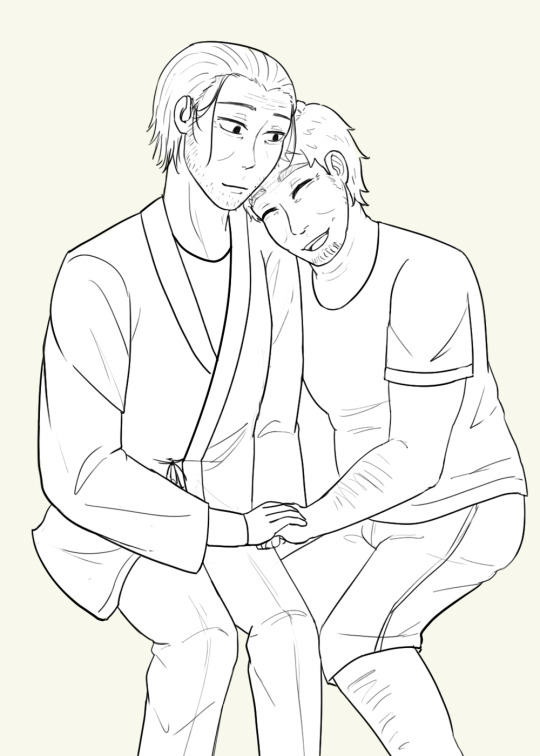
KazuRei Week Day 1 - Growing Old
when miri is fully grown and moves away from the family home, the papas move to the countryside and become the unofficial elder gays in the little village
#the papas deserve a good rest from the bustle of the city#rei is wearing a samue ! he likes casual yukatas bc its simple and loose (and very different from the suits that he used to wear)#kazuki just likes to wear a shirt and basketball shorts lmao#he also has a bit of a beer belly ;w;#most of the townsfolk privately refer to them as elder gays even tho they never officially told anyone but cmon.#no one's falling for the ''we've been roommates for almost four decades'' bs#they suck at giving advice tho... (baby gay: how did you guys come out to your parents?#kazuki: never told mine. we already weren't on speaking terms when i met rei so.#rei (trying not to say that his father tried to assassinate both his husband and child when he found out): ... yeah same#((also yes this is all inspired by barakamon lmao. its one of my favourite animes - slice of life comedy and has lots of cute kids in it!))#anyways first prompt done woo!!! happy kazurei week everybody!#this is the first fan week that im gonna participate in all the days (hopefully lmao i still have to do two other prompts)#also i tried to do a different style than my usual in the first pic and even tho im not entirely happy with it its eh. fine. lol#i just like rotating this half-cooked au in my mind hkfhkjfdgs#buddy daddies#kazurei#kazurei week 2023
53 notes
·
View notes
Note
Hi, I was just rereading today, and I still think it's hilarious how Tsumiki handles Megumi’s divine dogs😭😂


Nanami, highly experienced grade one sorcerer: *appropriately assessing the risks of shikigami in a highly aggressive attack mode whose sorcerer is not coherent enough to order them down properly, trying to find a solution that prevents injury without necessitating the destruction of the shikigami*
Tsumiki, has a decade of being secretly smug that her brother’s shikigami love her best under her belt, ready to bank it all on the fact that her brother’s dogs are Good Boys: nanami would you move your ass
#makis spent her entire life listening to her family never shut up about the ten shadows shikigami#had one try to rip her fucking throat out#only to have everything she thought she knew turned on her head by some rando high schooler who thinks of them as her baby brothers puppies#the Zenin: the divine dogs are ancient and deadly weapons revered by our clan#tsumiki comes home every day and asks her brother to summon them so she can give them belly rubs: they’re good boys is what they are#Shiro: *absolutely rabid levels of aggression against everyone*#tsumiki: :(#Shiro: *sad puppy mode*#sea glass gardens#next chapter still almost done just on brief hold due to work being crazy#when tsumiki was growing up kuro and Shiro was just megumis invisible puppies who walked them home from school and kept them safe#she has suchhh a different frame of reference for them#she remembers a time where she didn’t even know if they were real but she knew that they made her brother happy and that he loved them#so she loved them too#tsumiki was a scared little girl all on her own who’s brother was suddenly seeing horrible monsters but he also had his puppies to protect#them. she’s always adored kuro and Shiro because she views them as megumis protectors and companions
28 notes
·
View notes